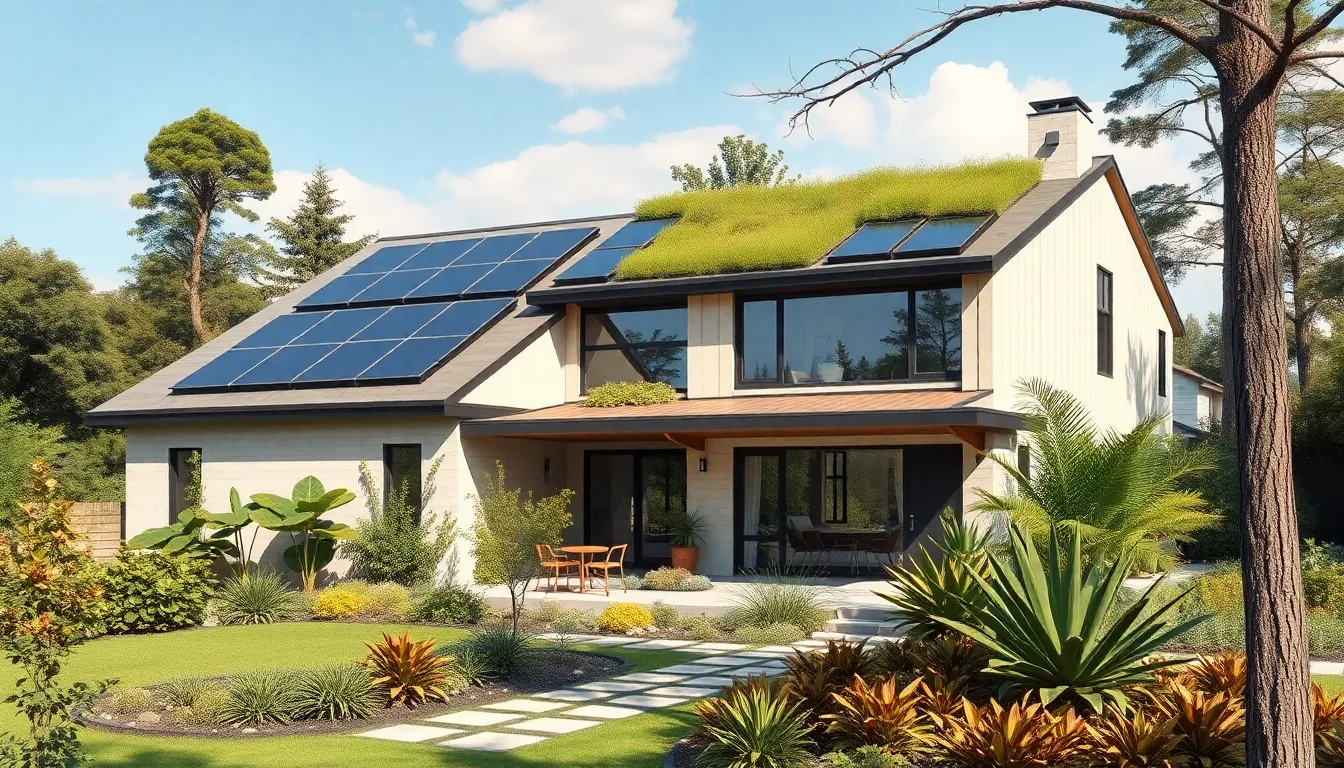Table of Contents
ToggleImagine living in a home that not only looks good but also gives Mother Nature a high-five. Eco-friendly homes are the superheroes of the housing world, swooping in to save the planet one energy-efficient light bulb at a time. They’re not just for tree-huggers anymore; these stylish abodes are all about comfort and sustainability, making them the ultimate win-win.
Overview of Eco-Friendly Homes
Eco-friendly homes integrate sustainable design elements that promote environmental health. These structures utilize renewable resources, employ energy-efficient solutions, and minimize waste during construction and occupancy. Architects incorporate passive design strategies, such as natural lighting and cross-ventilation, to enhance comfort without relying heavily on mechanical systems.
Materials play a vital role. Homebuilders prefer sustainable options like bamboo, recycled steel, or reclaimed wood. These choices not only decrease the carbon footprint but also exhibit durability and resilience over time. By opting for eco-friendly insulation, homeowners ensure reduced energy consumption while maintaining comfortable living conditions.
Energy efficiency remains a hallmark of eco-friendly homes. Incorporating solar panels or geothermal heating ensures a reliance on clean energy sources. Additionally, smart home technologies monitor energy use, allowing residents to optimize consumption patterns and lower utility bills.
Water conservation strategies also enhance the ecological footprint. Implementing rainwater harvesting systems, greywater recycling, and drought-resistant landscaping significantly reduces water usage. Consequently, such measures contribute to a more sustainable environment and support local ecosystems.
The appeal of eco-friendly homes extends beyond sustainability. Many find these residences visually attractive, combining modern aesthetics with natural materials. Eco-conscious designs often incorporate lush gardens, green roofs, or outdoor living spaces that connect homeowners with nature. Comfort, beauty, and ecological responsibility coexist harmoniously in these innovative dwellings.
Benefits of Eco-Friendly Homes

Eco-friendly homes offer numerous advantages, balancing environmental and health considerations. By incorporating sustainable practices, these homes contribute to a healthier planet and improve the well-being of their occupants.
Environmental Impact
Sustainable housing significantly reduces carbon emissions by utilizing renewable resources and energy-efficient technologies. A reduced reliance on fossil fuels not only lowers ecological footprints but also conserves natural resources. Integrating features like solar panels and energy-efficient appliances leads to decreased energy consumption, promoting a sustainable lifestyle. Furthermore, eco-friendly homes often include rainwater harvesting systems, which minimize water waste and encourage responsible water use. Choosing sustainable materials, such as recycled steel or reclaimed wood, contributes to reduced landfill waste while ensuring durability and longevity. Overall, eco-friendly homes create a positive impact on the environment by promoting resource conservation and minimizing adverse effects.
Health Benefits
Living in eco-friendly homes leads to improved indoor air quality, reducing pollutants and allergens significantly. Natural ventilation and optimal daylighting enhance comfort while lowering reliance on artificial lighting and HVAC systems. Healthier building materials, such as low-VOC paints and finishes, further contribute to a safer living environment. These homes often incorporate features like green roofs and non-toxic landscaping, which promote biodiversity and enhance mental well-being. Safer environments yield enhanced physical health, potentially lowering healthcare costs in the long run. Ultimately, eco-friendly homes foster a healthier lifestyle for residents while benefiting the broader community.
Key Features of Eco-Friendly Homes
Eco-friendly homes incorporate various distinctive features that promote sustainable living. These characteristics not only enhance comfort but also significantly contribute to environmental health.
Sustainable Materials
Sustainable materials like bamboo, recycled steel, and reclaimed wood stand out in eco-friendly homes. They reduce the carbon footprint while ensuring durability. Using these materials minimizes the need for virgin resources and lessens landfill waste. Additionally, the selection of non-toxic finishes further improves indoor air quality. Overall, choosing sustainable materials establishes a strong foundation for a healthier living space.
Energy Efficiency
Energy efficiency remains a hallmark of eco-friendly home design. Incorporating solar panels optimizes energy use while reducing utility costs. Smart home technologies further enhance energy management, allowing residents to monitor consumption in real-time. Many designs feature passive heating and cooling strategies, utilizing natural lighting and ventilation. Such practices lessen reliance on mechanical systems, promoting both comfort and energy savings.
Water Conservation
Water conservation strategies play a vital role in eco-friendly homes. Rainwater harvesting systems effectively capture and reuse water for landscaping and other non-potable uses. Drought-resistant landscaping not only minimizes water usage but also promotes native plant growth. Homeowners often install low-flow fixtures to reduce water consumption indoors. By prioritizing these approaches, eco-friendly homes significantly contribute to sustainable water practices.
Popular Eco-Friendly Home Designs
Eco-friendly home designs vary widely, each providing unique benefits while emphasizing sustainability.
Tiny Homes
Tiny homes emphasize simplicity and minimalism, showcasing efficient space utilization. With an average size of 400 square feet, these homes reduce energy consumption and resource use. Functional design elements, such as built-in furniture and multi-purpose spaces, optimize limited square footage. Often, builders use sustainable materials like reclaimed wood and recycled steel, ensuring eco-friendliness. Additionally, tiny homes often feature solar panels, enhancing energy efficiency. Potential homeowners appreciate the affordability that comes with lower utility bills and simpler living. Tiny homes encourage a lifestyle focused on experiences over possessions.
Passive Houses
Passive houses focus on energy efficiency and require minimal active heating and cooling. These homes integrate superior insulation, advanced air sealing, and high-performance windows. Typically, passive houses consume 80% less energy for heating and cooling than conventional homes. Natural ventilation and strategic building orientation allow for optimal daylight exposure. Homeowners enjoy comfortable indoor climates year-round without relying heavily on mechanical systems. Designed using sustainable materials, passive houses support reduced environmental impact. This design approach promotes both energy efficiency and lower utility costs, contributing positively to both budgets and the planet.
Eco-friendly homes represent a significant shift towards sustainable living that benefits both the environment and individual well-being. By merging style with sustainability these homes not only reduce carbon footprints but also enhance indoor air quality and promote healthier lifestyles.
With innovative designs and energy-efficient technologies they offer practical solutions for modern living. As more people embrace these concepts the demand for eco-friendly homes will likely continue to grow.
Ultimately choosing an eco-friendly home is a step towards a more sustainable future that balances comfort beauty and ecological responsibility.







